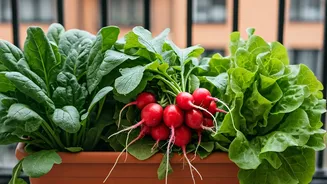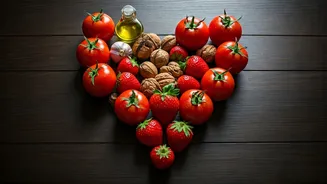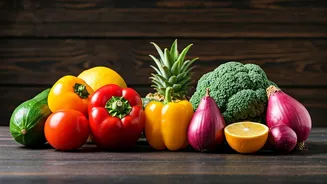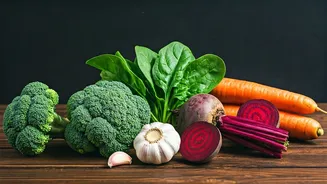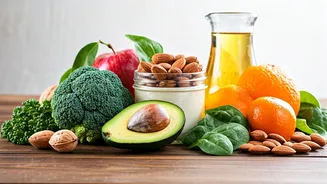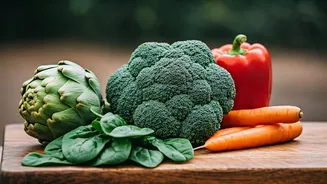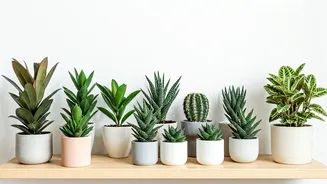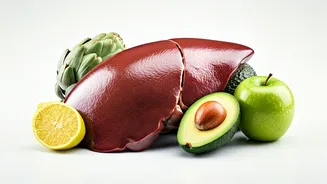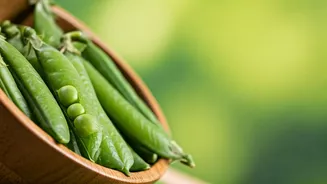Embrace Balcony Gardening
Balcony gardening offers a fantastic opportunity to enjoy fresh, homegrown produce even without a traditional garden. With the right selection of vegetables
and a bit of care, you can transform your balcony into a productive space, providing a continuous supply of nutritious food. The key is choosing the right vegetables, such as those that thrive in containers and require moderate sunlight and care. This guide focuses on five vegetables well-suited for winter harvests, making it easy for anyone to start their gardening journey. Whether you are a beginner or a seasoned gardener, growing vegetables on your balcony can be a rewarding and enjoyable experience.
Spinach: Leafy Green Delight
Spinach is a versatile and easy-to-grow leafy green, perfect for winter cultivation on a balcony. Its adaptability to cooler temperatures makes it an ideal choice for the colder months. To begin, select a container with good drainage and fill it with nutrient-rich potting mix. Sow spinach seeds directly into the soil, spacing them about an inch apart. Cover the seeds lightly with soil and water gently. Place the container in a location that receives at least four to six hours of sunlight per day. Water regularly, ensuring the soil remains moist but not waterlogged. Spinach typically matures within a month, and you can harvest the outer leaves as needed, allowing the inner leaves to continue growing. This method ensures a continuous supply of fresh spinach for your salads and dishes throughout the winter.
Radishes: Quick and Easy
Radishes are known for their rapid growth, making them an excellent choice for impatient gardeners. They grow well in containers and require minimal care. Choose a container at least six inches deep and fill it with well-draining soil. Plant the radish seeds about half an inch deep and space them approximately one inch apart. Water the seeds gently and ensure the soil remains moist. Radishes prefer full sun but can tolerate partial shade. They mature in as little as 20 to 30 days, offering a quick harvest. You can harvest the radishes when they reach a suitable size, typically about an inch in diameter. Regular watering and a sunny spot on your balcony will ensure a consistent supply of these crunchy, peppery delights.
Carrots: Root Vegetable Success
Growing carrots on a balcony requires a container at least 12 inches deep to allow for root development. Select a container with good drainage and fill it with a loose, well-draining soil mix. Sow carrot seeds about half an inch deep, spacing them approximately two inches apart. Water the soil gently after planting. Carrots thrive in full sun, so position the container in a sunny spot. Thin the seedlings as they grow, leaving the strongest ones to mature. Water regularly, ensuring the soil remains consistently moist. Carrots usually take about two to three months to mature, depending on the variety. Gently pull them from the soil when they reach the desired size. Freshly harvested carrots from your balcony offer a sweet and flavorful addition to your winter meals.
Peas: Climbing Winter Harvest
Peas are a fantastic choice for vertical gardening on a balcony, providing a lush green display and a delicious harvest. Select a container at least 12 inches deep and provide support for the pea plants to climb, such as a trellis or netting. Plant pea seeds about an inch deep and space them approximately two inches apart. Water the soil thoroughly after planting. Peas prefer full sun but will also tolerate partial shade. Regularly water the plants, ensuring the soil remains moist. Peas typically mature within two to three months, and you can harvest them by picking the pods when they are plump and full. Growing peas on your balcony can provide a continuous supply of fresh, sweet peas throughout the winter season.
Mustard Greens: Flavorful and Nutritious
Mustard greens, with their peppery and slightly spicy flavor, are a great addition to your balcony garden. They are easy to grow and thrive in cooler temperatures. Choose a container with good drainage and fill it with nutrient-rich soil. Sow mustard green seeds directly into the soil, spacing them about an inch apart. Lightly cover the seeds and water gently. Position the container in a location that receives at least four to six hours of sunlight per day. Water regularly, ensuring the soil remains moist but not waterlogged. Mustard greens typically mature in about a month, and you can harvest the leaves as needed, picking the outer leaves first to encourage continued growth. This method ensures a continuous supply of flavorful and nutritious greens for your winter salads and dishes.
